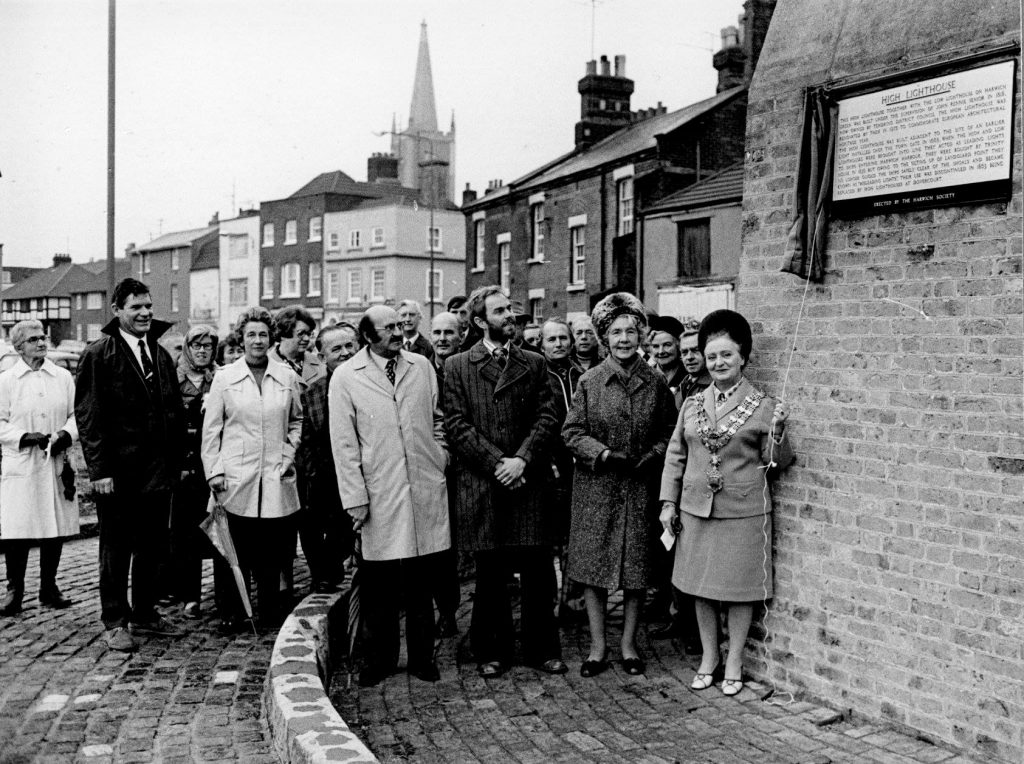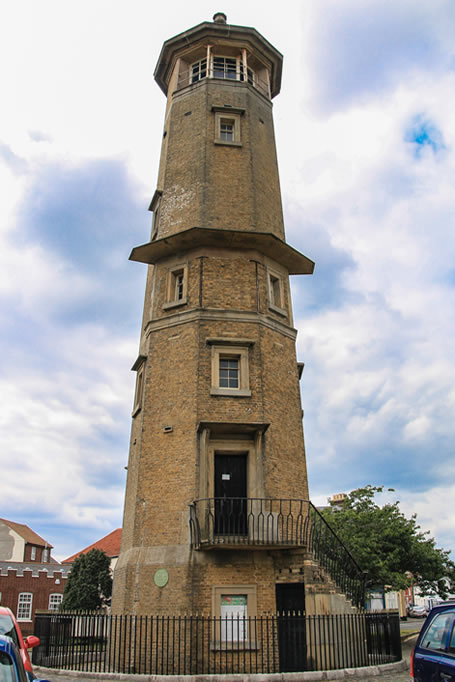Built in 1818 to replace a light over the Town Gate. This and the Low Lighthouse were used in transit to aid navigation into the harbour. Withdrawn from service in 1862 and now houses a museum of local interest.
High Lighthouse
There have been three pairs of lighthouses through the ages, from the original wooden pair, which no longer exist, then the brick built ones that still stand in Harwich, to the cast iron ones that still stand on Dovercourt Seafront. None of these existing lighthouses are used for navigation purposes today. The brick lighthouses in Harwich were built in 1818 under the supervision of John Rennie Senior to replace earlier wooden ones. They belonged to General Rebow who became very rich by charging 1d per ton light duties on all cargoes coming into the port. But in 1836 Trinity House (TH) acquired the Harwich Lights from General Rebow for £31,730, there being 12 years and 5 days remaining of his lease. It is suspected that Rebow had become aware of the changing course of the channel.
The lighthouses became redundant in 1863 for just this reason and the new cast iron lighthouses were erected at Dovercourt opposite the present tennis courts. The High Lighthouse continued to be used by mariners as a landmark. In 1909, the High and Low Lighthouses were sold to the Borough Council. The Low Lighthouse was vested in the Harwich Corporation for 10/- (50p), but with the condition that it should be returned to TH if needed for navigational purposes. The lighthouse became redundant in 1863 and the new cast iron lighthouses were erected at Dovercourt opposite the present tennis courts. The High Lighthouse continued to be used by mariners as a landmark. In 1909, the High and Low Lighthouses were sold to the Borough Council. The Low Lighthouse was vested in the Harwich Corporation for 10/- (50p), but with the condition that it should be returned to TH if needed for navigational purposes. TH in fact took it over again in 1970 and converted it into a pilot signal station. In 1974, it reverted to Tendring District Council (TDC) on completion of the new Pilot Station at Angel gate. It became the Maritime Museum of the Harwich Society in 1980.
TH in fact took it over again in 1970 and converted it into a pilot signal station. In 1974, it reverted to Tendring District Council (TDC) on completion of the new Pilot Station at Angel gate. It became the Maritime Museum of the Harwich Society in 1980 and is open to the public daily from 1000 – 1600 1st May to the middle of September.
The High Lighthouse was sold for £75 (without restriction) and was used as a residence. The High Lighthouse is now run by Harwich Society as a museum of local interest . Open at weekend afternoons during the summer. It was renovated by TDC as their contribution to Architectural Heritage Year 1975.
The Harwich High and Low Lighthouses are 150 yards apart and were leading lights, i.e. they worked as a pair; with one light positioned over the other (as seen from the sea). The vessel was then on the correct course. The Low Lighthouse is a 45ft (16.5 metre) high, ten-sided tower of brick. The ground storey has a projecting canopy to provide public shelter. The High Lighthouse is a 90ft (32.8 metre) high, nine-sided tower of grey gault brick. The lighthouses were built 9ft (3.3 metre) to the south west of the original sites. The old wooden Low Lighthouse was built by the beach and is portrayed in one of Constable’s paintings. The old High Lighthouse was over the Town Gate (on the Felixstowe side of the present High Lighthouse). Both earlier lighthouses were coal fired.
October 30th 1976 saw the unveiling of our plaque on the High Lighthouse at Harwich.

The morning was cold and drear but it did not deter about fifty faithful members from attending the ceremony which was performed by the Mayor of Harwich, Councillor Mrs Georgina Potter, Also present were the Chief Technical Officer of Tendring District Council, Mr C. Bellows, and Mr Henry Lambon and Mr Tom Judson, chairman and secretary respectively of the Colchester Branch of the Royal Institute of British Architects.
Winifred Cooper (1976)
The High Lighthouse is opposite the Train and Bus Station and there is free parking on the road nearby.
Accessible by Public Transport:
Open 1st May to middle of September.
Sunday 11:00 – 15:00
Bank Holidays and Heritage Open Days.
During school summer holidays, Monday & Friday 11:00 – 15:00
Annual Motorcycle Run.
Half days Sat & Sun for the Harwich International Shanty Festival.
Admission Costs
Adults £2, accompanied children free. No concessions.
